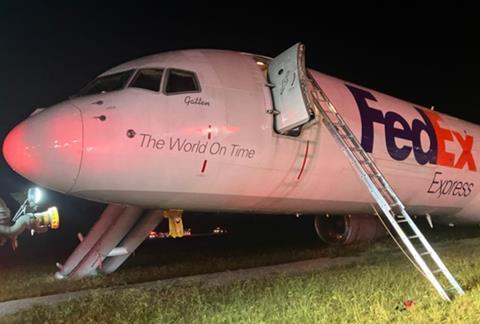US investigators have disclosed that a hydraulic system failure just after take-off preceded the gear-up landing by a FedEx Boeing 757-200 freighter at Chattanooga earlier this month.
Examination of the aircraft following the accident revealed that a left-hand landing-gear door retraction actuator hose was leaking hydraulic fluid.
The National Transportation Safety Board says it has removed and retained the hose for further inspection.
Preliminary findings of the investigation state that the aircraft’s left hydraulic system failed as the twinjet departed Chattanooga for Memphis on 4 October.
There were no maintenance issues before the flight. Flight-data recorder information shows the landing-gear was retracted as the aircraft climbed and shortly afterwards the crew moved the flap handle to retract the flaps.
According to the pilots they immediately received a ‘flap disagree’ message and other related warnings, and the first officer began running the corresponding checklist from the quick-reference handbook.

The crew managed to retract the flaps using an alternate means but then – with the aircraft still less than 2,000ft above ground – received an alert regarding the left-hand hydraulic system, which was unpressurised with a fluid quantity near zero.
While the first officer turned to address the hydraulic system checklist, the aircraft turned back to Chattanooga.
The 757 is designed with three hydraulic systems – centre, left and right – and complete loss of left-system pressure means the flaps, slats and landing-gear must be deployed using alternate systems.
According to the inquiry the crew had received a gear-unsafe indication while trying to extend it for landing, but “multiple” attempts to lower the landing-gear through the alternate-extension procedure were “unsuccessful”.
A low pass over the runway at 150ft provided visual confirmation from tower controllers that the landing-gear was not lowered, and the crew conducted a gear-up landing on runway 20.

“[The crew] reported that during the initial touchdown the airplane bounced slightly but they were able to maintain directional control and the runway’s centreline,” says the safety board.
But the 757 could not stop in time to avoid overrunning and it collided with the localiser antenna before coming to rest 830ft beyond the runway end.
While the twinjet sustained substantial damage, neither the two pilots nor the individual in the jumpseat – the only people on board – was injured. The inquiry says, however, that the jumpseat occupant encountered difficulty opening both forward doors during the evacuation.
Investigators have yet to reach formal conclusions over the cause of the hydraulic failure and the crew’s inability to lower the landing-gear.
But the inquiry states that, during their inspection of the aircraft, investigators found a “discontinuity” in the wiring of the alternate-extension system for the landing-gear, and have retained this section of wiring along with the actuator hydraulic hose.


























